The last time you saw Bob Benjamin’s Master’s Workshop it was part of FLY RC Magazine and this home page had a different look. As most of you probably know by now, FLY RC is gone. I spent the better part of a year working behind the scenes with the handful of creative people, writing new content to help save the title but our combined enthusiasm wasn’t enough to do the job. As many of you also know, as that dust settled I arranged to work with Model Aviation Magazine to continue to create the same kind of material…stuff about BUILDING model airplanes instead of BUYING them…with the entire AMA membership as my new audience. The working relationship between Model Aviation and rcmodel.com is something new. Instead of using this website to enlarge and expand on the limited amount of material that magazine readers could see on the printed page, Master’s Workshop online content will from now on be unique to the website. You are going to have to read both Model Aviation Magazine and stay current with my new building model airplanes blog series to get to see everything I’m working on.
It is my understanding that for the immediate future the magazine is going to continue with my Guillow’s Kit Conversion series including at last one serialized Build-along-with Bob feature based on one of their popular classic balsa kits. Here are several extra photos of “Guillow’s Project” models that you won’t see in the print magazine.
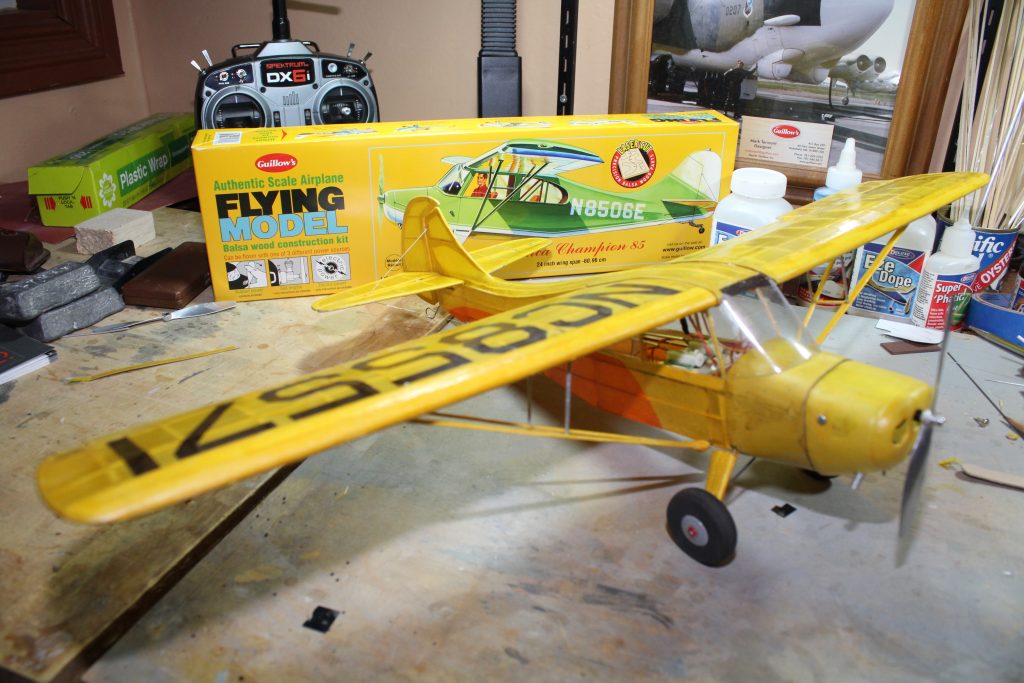
Earlier this year Model Aviation featured my article on silkspan covering using the Guillow’s Kit. 301 LC Aeronca Champion as the subject. Here’s a shot of the completed Champ on my small model work table with the kit box and the Spektrum DX-6i I use to fly it in the background. I am not going to tell you any more about here; you’ll have to check out the March, 2018 issue of MA to see all the details.
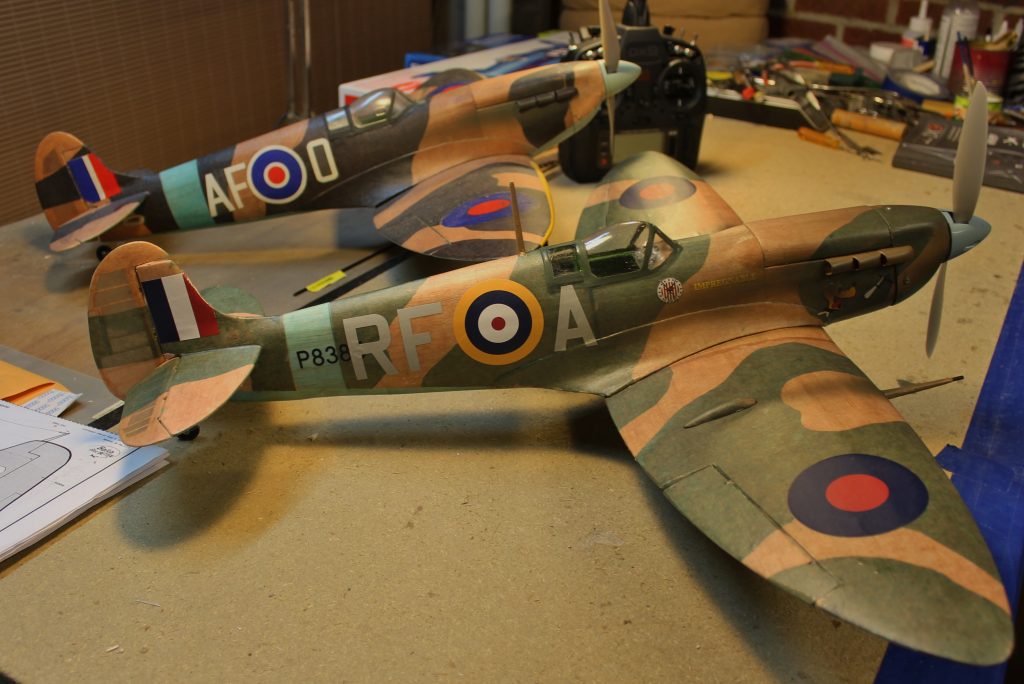
I have mentioned RC conversions of the Guillow’s Kit 403 LC Spitfire in several different magazine features. Here is an extra image of the first two of the series of three I have built and flown so far.
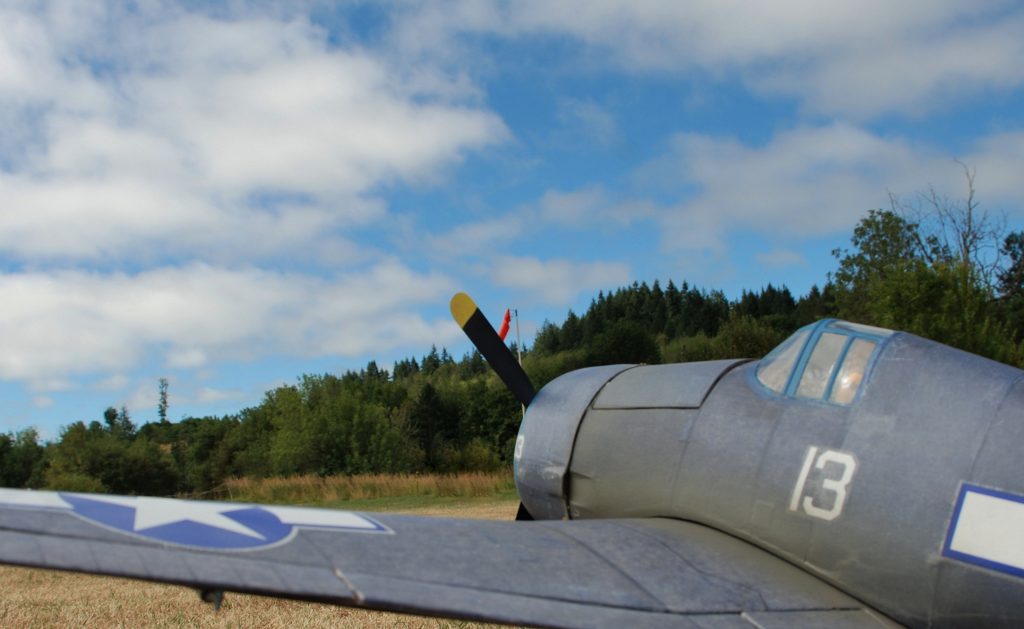
As of late summer of 2018 Model Aviation has scheduled publication of the first of a series detailing the RC conversion of Guillow’s Kit 1005 Hellcat for early 2019. This image of that model counts as a classic “sneak peek” of what’s coming.
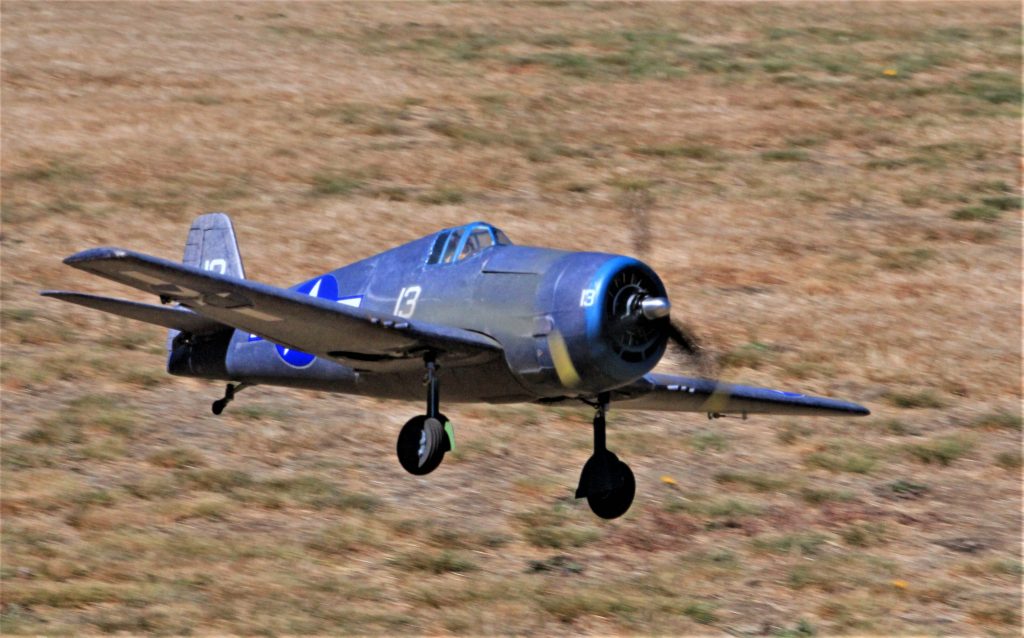
This is the same Hellcat. These things fly…but you have to wait for that future issue of MA to see all the other flight shots we have ready.
What would you like to see me do with the new Master’s Workshop online? I could continue with more advanced building discussion of sophisticated kits like the FlyLine Great Lakes Trainer, the TF Stinson and the Tritle/Brodak B-17…or…as an alternative, would you prefer that I devote some of my online space to really hard-core scale aeromodeler stuff? For example, I have a less than perfect (no longer collectable) Cleveland Master Series stick-and-tissue WWII job stashed away. What if I were to share the experience of building that kit with you, step by step, explaining every detail of things like creating working control surfaces, retract gear installation, practical dummy engines and simulated panel detail and so on in what began as a rubber-powered free flight design? I understand that very few of us have dusty seventy-year-old kits laying around. My intent with a project like this would not be to write another build-along, but to let you watch while I pull out all the stops and demonstrate some of the neat things I have learned over the years.
Speaking of that B-17, some of you who have been following rcmodel.com for a while may remember that we never got the entire building blog series published a part of the FLY RC experience. It happens that I have all that “missing” material safe in my files. Please let me know if you would like to see Parts 22 through 25 brought up to date right here.
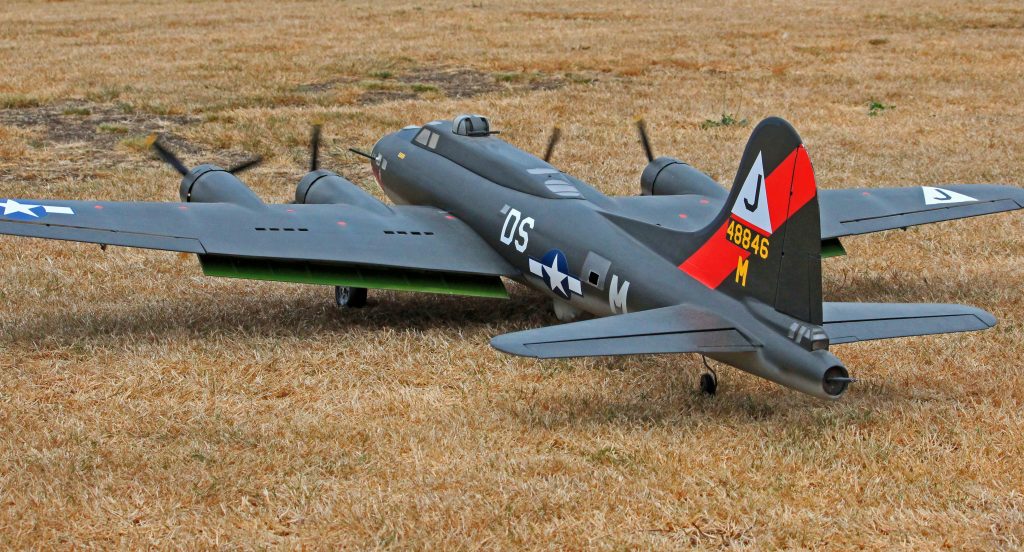
As you can imagine when the B-17 was finally ready for that first for-real trip to the flying field we took lots of pictures. Here’s one of the extras to remind you of that project from several years ago that I am talking about.
There’s more. I have two somewhat different projects in the works already. Remember all those references I have made in the past to various products, such as EzeKote, SuperPhatic, etc. from Deluxe Materials that are part of just about everything I build? There are several more that I want you to know about, such as EzeDope and Tissue Paste, so in the very near future I am going to share the process of building one of the KeilKraft (from the UK) classic stick-and-tissue rubber-powered models built per the kit as a free flight.
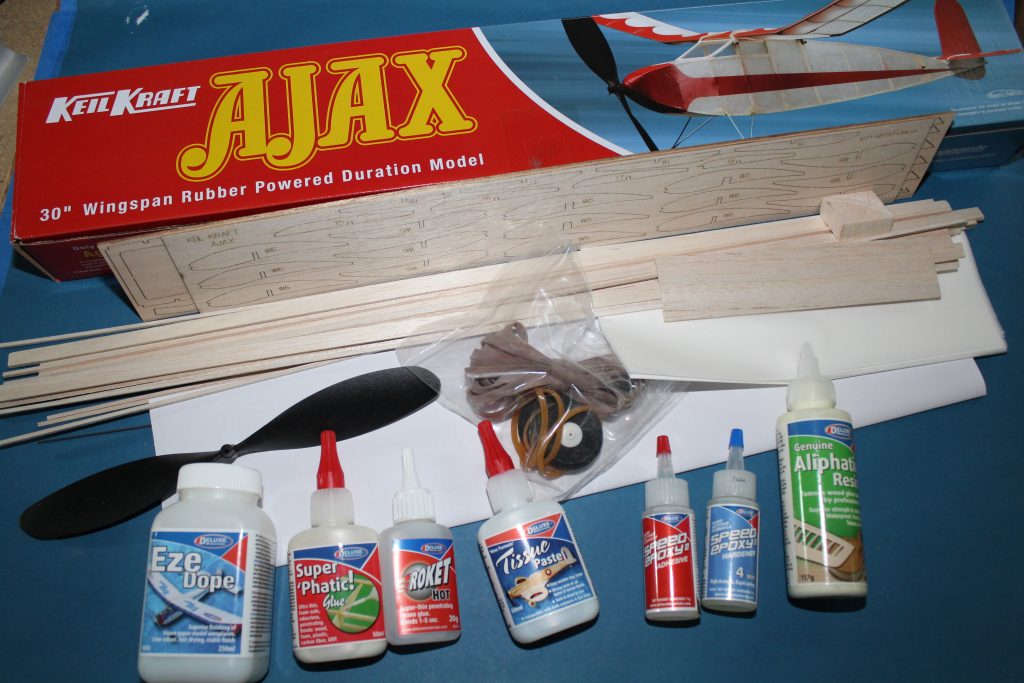
originally designed. This is a British KeilKraft AJAX kit, one of a series of vintage balsa kits that is being brought back to today’s market with really good balsa and precise laser cutting…something that did not exist during the 1940’s and ‘50’s when these models and others like them were easy to find in hobby shops everywhere. I will not be doing conversion of any kind here…this model will be box-stock. All the parts and materials you see here are going into the model. I am not going to substitute, upgrade or replace anything.
In the past I have said a lot about using those good old rubber powered free flight kits as the starting point for electric powered RC conversions. Now we get to build one as it was
originally designed. This is a British KeilKraft AJAX kit, one of a series of vintage balsa kits that is being brought back to today’s market with really good balsa and precise laser cutting…something that did not exist during the 1940’s and ‘50’s when these models and others like them were easy to find in hobby shops everywhere. I will not be doing conversion of any kind here…this model will be box-stock. All the parts and materials you see here are going into the model. I am not going to substitute, upgrade or replace anything.
And…I am going to do some restoration of an older model you may recognize from the “roller” images at the top of this page. I built that C-47 (military DC-3) about ten years ago to be featured as a product review/electric conversion article in FLY RC’s Warbirds Volume One published in 2009. Because it was based on a Great Planes /TOP FLITE Gold Edition scale balsa kit I used their proprietary hardware, including both motors and ESC’s, throughout the project. When I made the decision to dust the old model off and restore it to flight status, I chose to replace those with contemporary products that my experience has shown to provide superior performance. What’s going to happen here is that right after we are finished with that stick-and-tissue KeilKraft kit I will take through a detailed explanation of how I removed all that old stuff without compromising any of the pre-existing aircraft structure in which it was mounted and show you how I replaced it with new Innov8tive Design Cobra motors and ESC’s and Venom Products LiPo packs that I integrated into the existing airplane with a minimum of redesign.
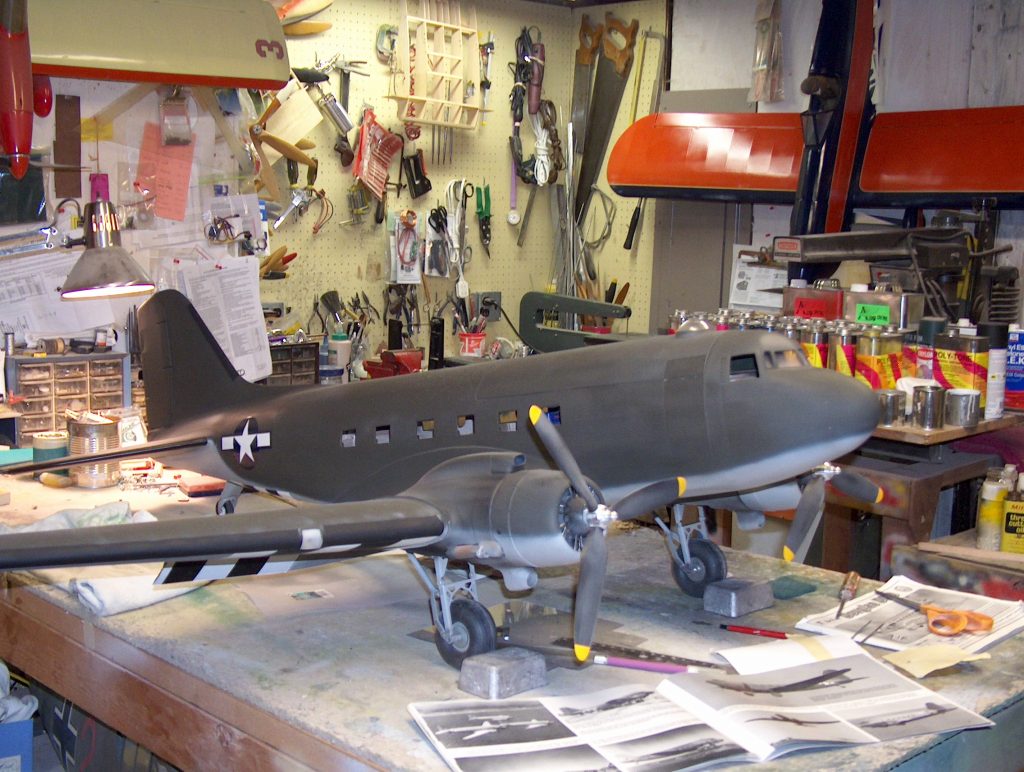
This is the just-completed TOP FLITE C-47 in my shop about ten years ago, surrounded by pages of scale reference data, just before the first test flight…
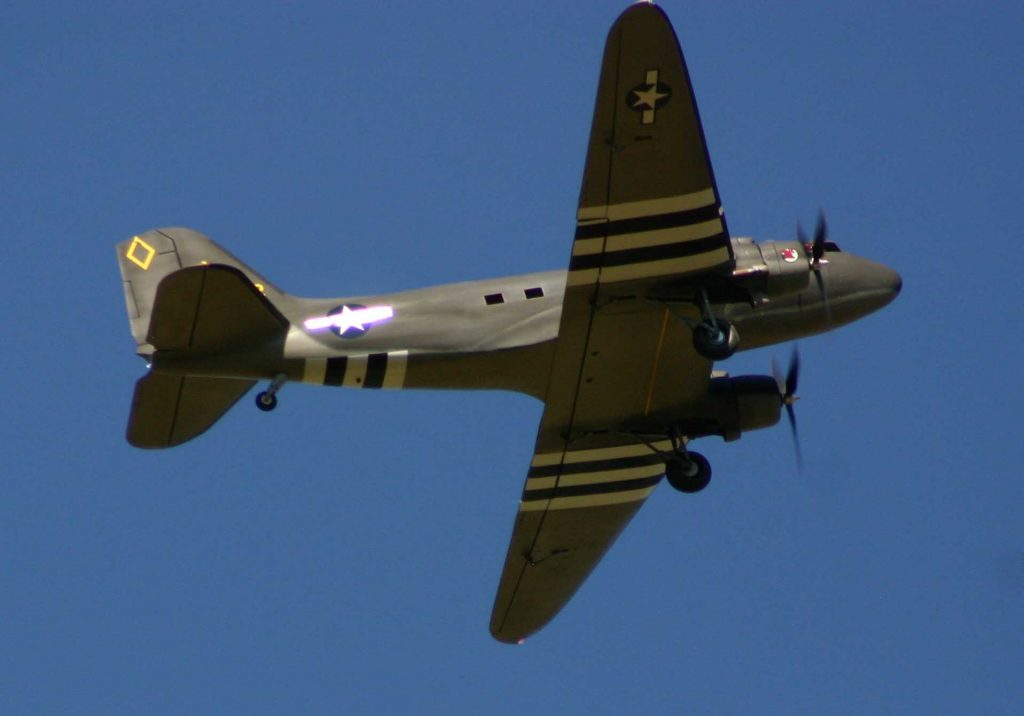
…and, all that worked out just as it was supposed to. This is the takeoff of the fourth or fifth flight. As you can see the true-to-the-manufacturer’s-specs motors, ESC’s and other components worked just as designed, but there are improved products available now and I’m going to show you exactly how to retrofit them.
What was I doing while all this planning and website design update work was going on? What follows are several photos of the airplanes that came out of my shop during the time it wasn’t practical to tell you about them online. Not long after I finished getting that C-47 electric conversion from the TOP FLITE kit test flown and trimmed out I had the
opportunity to work on the electric conversion/kit review of another TOP FLITE Gold Edition kit, the 1/5 scale Beech T-34-B Mentor. As it happened some of the uncertainty that surrounded the disappearance of FLY RC managed to find its way into the kit review agreement with the eventual result that my commitment to finish the airplane and write about it disappeared. As there were several other big projects going on in my shop at the time the partially-completed T-34-B began to collect dust. To make a long story short, I began to feel sorry for the partially-constructed wing and tail surfaces, pulled them back out into the light, and finished building the airplane. What a good idea that was!
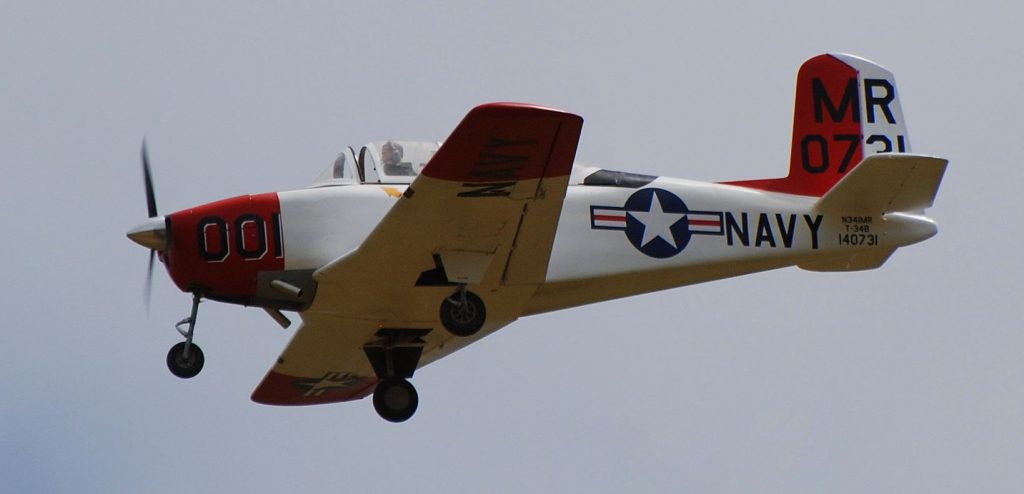
I built this T-34-B Mentor by the book, making a point of following the TOP FLITE kit plans and instruction manual just about word-for-word except for the electric power system. The Robart No. 630BNZ pneumatic retractable landing gear system along with all the control linkages and hinges and other hardware were standard stuff…but…when it came to covering and finish I stayed with my usual practice and substituted Deluxe Materials EzeKote and fiberglass cloth along with Stits PolyTone paint products for the recommended MonoKote. The E-powered 1/5 scale Mentor turned out to be one of my favorite weekend flyer airplanes.
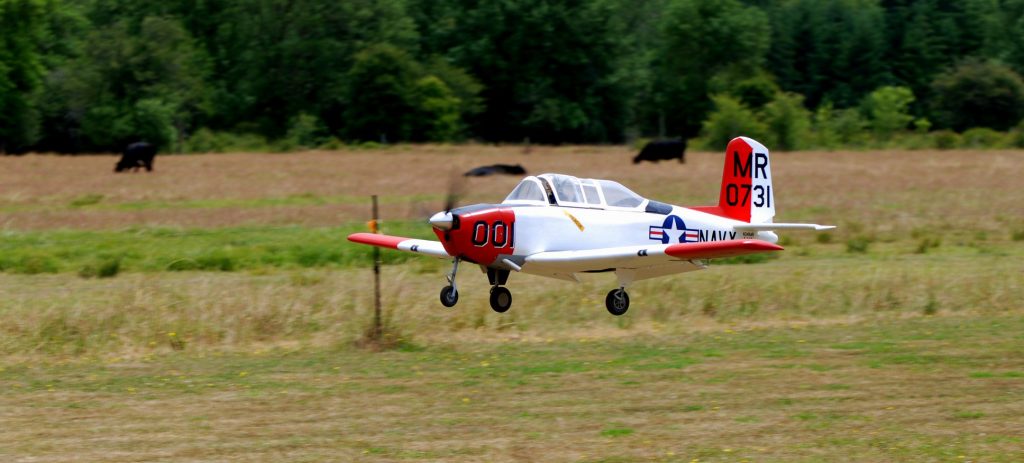
This is a “happy” airplane to fly. The Rimfire 120 brushless motor running on a 6Sx5000mAh Venom Products FLY series LiPo pack and turning a stock Master Airscrew 15×8 3-blade prop provides just-beyond-scale power for easy takeoffs from that grass runway and, yes, it IS a working cow pasture.
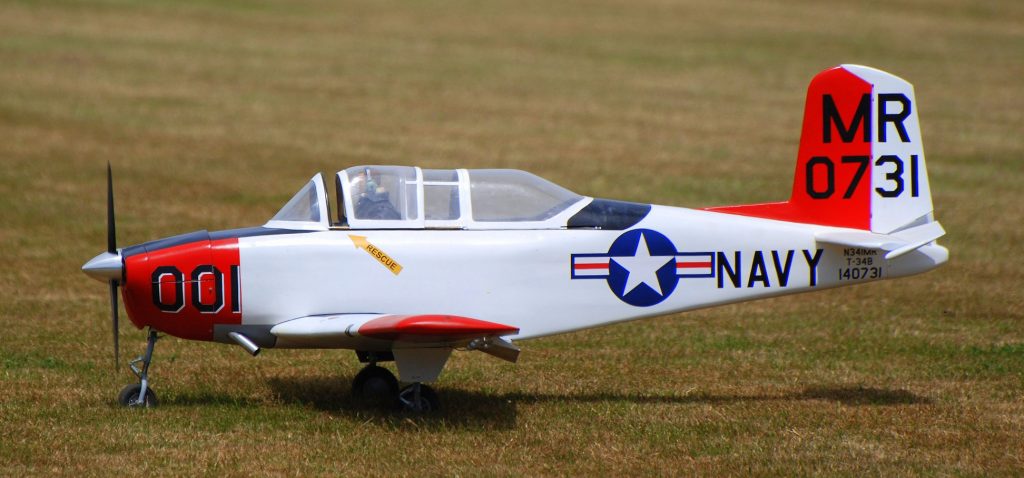
I went beyond the kit-standard green-on-yellow finish and researched a restored, civilian-owned T-34-B to reproduce. All the white, red and black portions of my airplane are masked and sprayed Stits PolyTone. The markings are a custom job created by Callie Graphics to match the documentation I provided. You can’t see much of it from here but I did an all-out detail job on the interior using the standard TOP FLITE cockpit detail accessory kit. What you can see is that 1/5 scale Civilian Pilot figure from Warbird Pilots http://www.warbirdpilots.com/ . These pilot figures aren’t cheap, but their realism demands that you take a second look at any interior they’re installed in.
How many times have I shared my interest in working with good old traditional silkspan and clear dope? This airplane is the direct result of a behind-the-scenes project I worked on over ten years ago. As the photos suggest this is another of those “happy” airplanes to fly.

This 1/8 scale (54”span) Piper PA-11 is another classic all-balsa airplane built from my own plans. It betrays my interest in trying to accomplish several things at once. The internal structure…rib, stringer and longeron spacing, etc…comes very close to true scale accuracy, but the covering finish reflects a different goal. This PA-11 is covered in real SGM silkspan from those good old days (I found the lot on the back of a dusty shelf) and, yes, I used the Rit Dye method I’ve written about elsewhere to get those “antique-looking” blue and orange colors. The finish is standard “full scale” clear nitrate dope from a supply I have kept on hand for even longer than this model has been around. The first two clear dope coats used full-tautening dope, then I went to another of those old one-gallon cans for some of the non-tautening variety to keep from over-shrinking the covering.
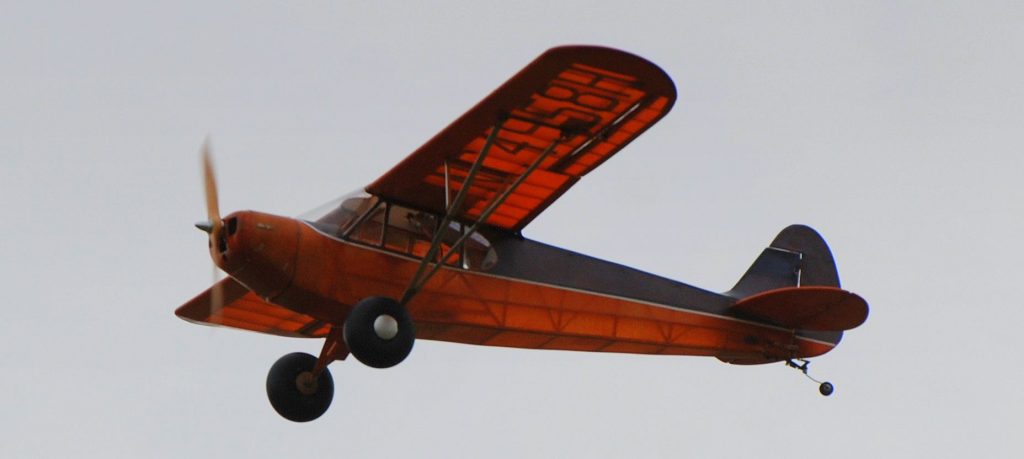
My reason for using that clear doped dyed silkspan was of course to re-create the esthetic effect of what has long been considered one of the best ways to get an interesting colored finish without using much heavier pigmented dope. It still works just fine if you are willing to invest some extra effort. Those functional-looking wing struts really are…I built them up from K&S streamlined aluminum tube, soldered sheet brass fittings, 2-56 threaded rod ends and a few other odd scraps from my shop. They do in fact work to fine-tune the dihedral and washout angles.
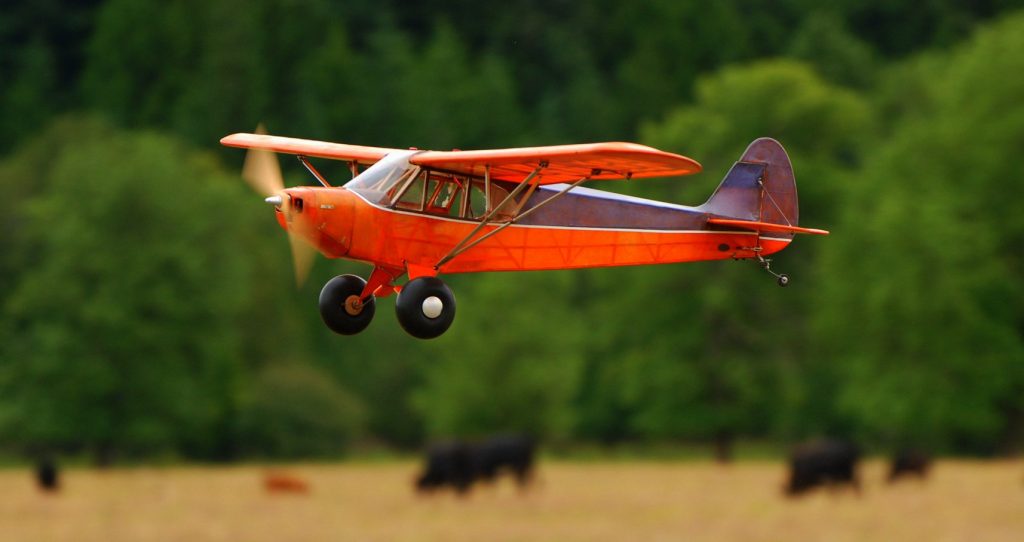
OK, so what’s a PA-11? The Cub Special from 1947 was essentially a J-3 with a reinforced nose, a 90 HP engine in place of the earlier 65, and a full cowl. This design, with an even larger engine, flaps and a few other details became the PA-18 Super Cub. And, oh yeah, those big fat oversize wheels that seem perfect for a Cub doing bush duty are in fact Trexler Airwheels which have been on the model airplane market (if you look hard enough for them) since before WWII.
I have saved the best for last. Several years ago an old friend and fellow scale aeromodeler, John Bolle, called one day after being out of touch for quite a while to tell me that deteriorating health was forcing him to move to a licensed full-time care facility. As is the nature of such places there was not going to be any room for even little models, let alone his long-established shop overflowing with years and years of building serious RC scale airplanes, including quite a few that were legitimately self-designed and scratch-built. John went on to explain not only that no one in his family had any interest in the kind of model airplanes that you had to BUILD, but that indeed he couldn’t find anybody in the entire Seattle-area RC community he felt he could trust to know what to do with a shop full of large, complex, electric-powered scale airplanes. He also reminded me of the times we had spent together working out how far we could push the limits back in the days of NiCd cells and brushed motors to get improbable models like his Bellanca Trimotor into the air. And then he said, “Bob, you’re the only person I know who would appreciate…understand… this stuff. I want you to come over and take all my stuff…shop supplies, tools, airplanes, all of it. The only thing I’ll ask is that you do your best to get some the planes I haven’t been able to finish into the air.”
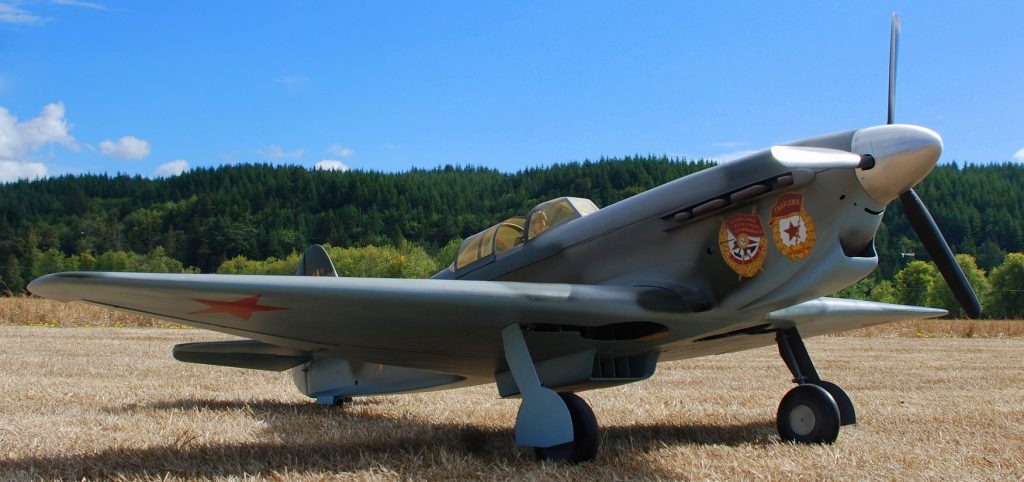
I found this 1/5 scale YAK 9D Russian/Soviet fighter from 1944 sitting half-built in the middle of it all. The YAK 9 was one of a series of WWII fighters that were among the most successful with which the Red Air Force was equipped. John drew his own (very detailed) plans from an extensive set of full scale reference drawings, which he passed on to me, and this model would easily meet TOP GUN standards for accuracy. I decided to finish it as an electric, as intended by John, and used the largest motor that was then available to me, a RimFire 65 outrunner running on 12S x 5000 mAh Venom Power LiPo’s. The full scale YAK had a fabric-covered, steel-tube fuselage and plywood-skinned wing and tail surfaces. I chose to use 2 OZ/sq.ft. fiberglass cloth and epoxy resin for the base surface, with Stits PolyTone products for the color finish.
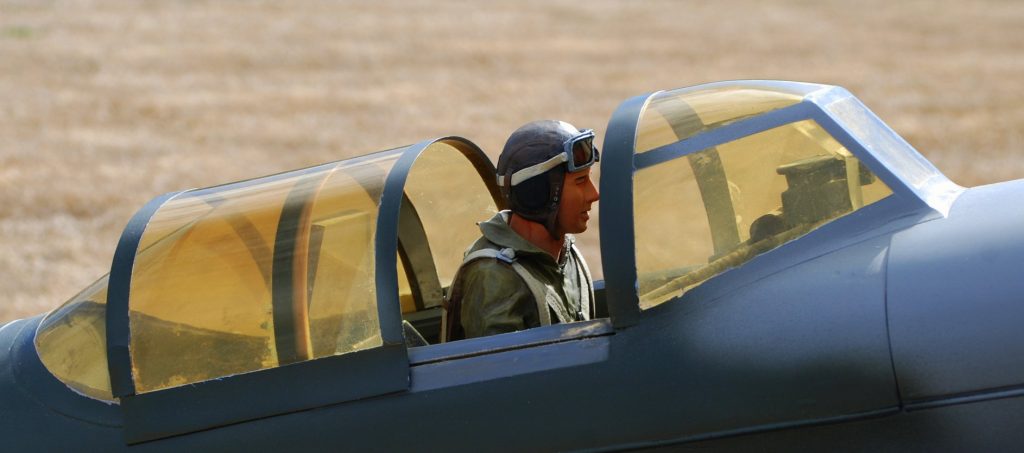
As with the T-34 it was easy to decide that this airplane called out for a top quality pilot. In this case I went for the best I could get…a Best Pilots ( www.bestpilots.typepad.com/) 1/5 scale figure in a custom-made 1944 summer campaign fighter pilot uniform appropriate for a YAK 9D.
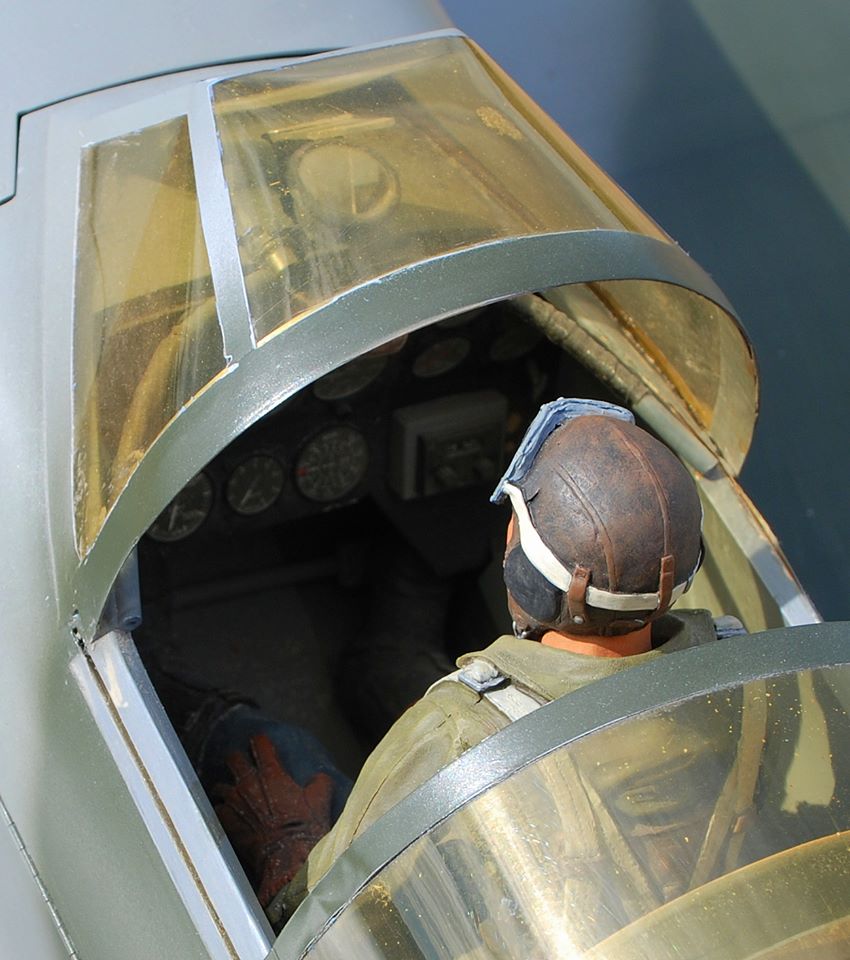
Our Russian friend looks good from behind as well. If you look closely you can see the instrument panel and that unique-looking Soviet gunsight that I researched and built from scratch.
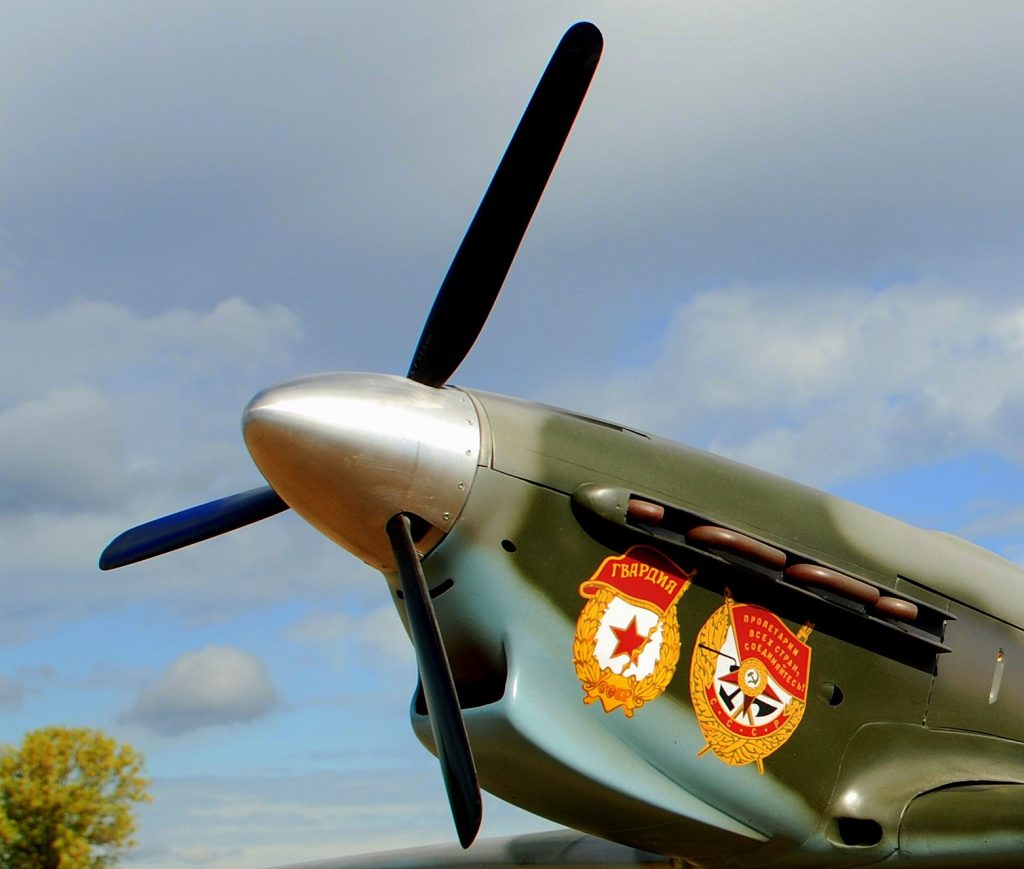
This is the working/flying prop, which is pretty close to scale although still a bit undersize. In fact it is a three-blade D series Ramoser VarioProp fitted with 23” blades set at about 16” of pitch. I’ll need to do some more flying to be sure, but I think this is pretty close to optimum for what I expect from this model. The spinner is a custom-turned job that John had already found for the YAK when he gave it to me. Those markings, which are contemporary Soviet political emblems, came from Callie Graphics.
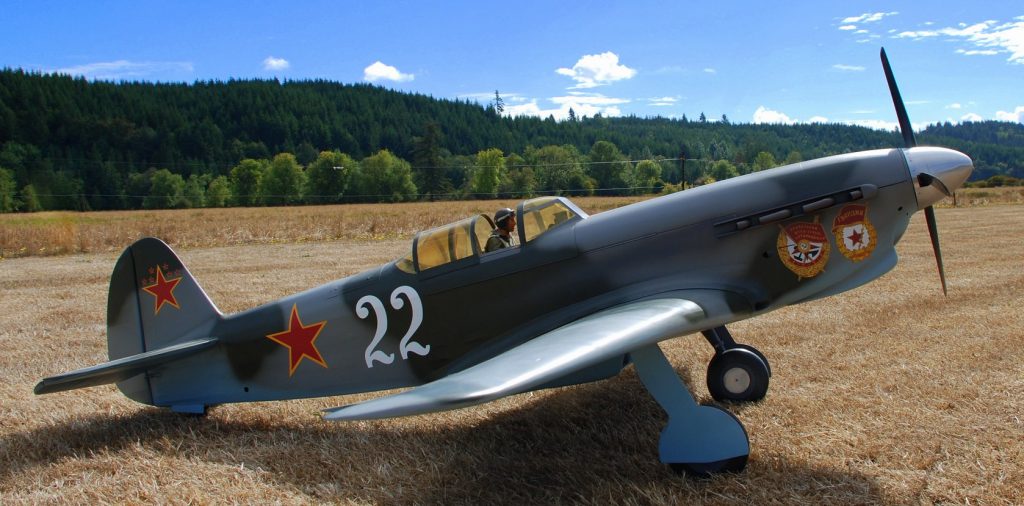
I’ll leave you with this shot to think about. There are in fact several scale details (like the radio antenna mast and nose cannon barrel) that aren’t in place yet. I’ll get those done as I become more comfortable flying this thing.

Bob,
Love your builds and excellent photos.
I am very interested in seeing the rest of your B17 build.
I would like to see a build from selecting a subject
All the way to flying it.
hi bobb PLEASE do finish the B-17F SERIES !!! i need 22-25 to complete my build set of your excelent build articles. i have been very happy to find your new ( to me) site.. i am of the old school and prefer to build not arf it!!!
Seems to me that Model Aviation magazine is dropping the ball by not publishing your excellent material. I read your articles in Fly RC every month and enjoyed them all. Many months have passed since I heard about your new deal with MA, and I miss your serialized construction articles. Will this be changing in the near future?
Gaylan,
The long and short of it is that Model Aviation can’t make the space to accept a monthly serialized construction feature, even though they assure me that they would like to use my material. In the end I have decided to do things a bit differently in the future. Although I may publish an occasional article in the print magazines, from now on I will be focusing all my efforts on the website. The immediate result of this decision will be WAY more new content on rcmodel.com. (I just added another of those “lost” B-17 chapters yesterday). You can help by passing this info on to any aeromodelers you might know personally AND making sure you keep up with my offerings on the Bob’s Books tab.
Bob
Hi Bob,
This may be my last project, but I am converting a Guillow DC-3 to RC. The landing gear is my stumbling block to finish this plane and was wondering if you could send me some ideas to build or I would even buy a fixed gear that will allow me to finish this project
I am a former pilot of 49 years and built my own Glastar the we flew to FL and Oshkosh on several occasions, but sold it 8 years ago and now fly and build RC models. Great models and wish I had 1/4 of your talent.
Thanks for your help.